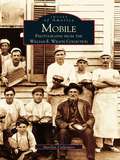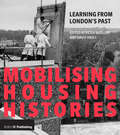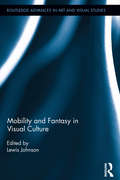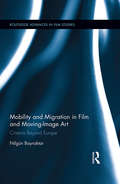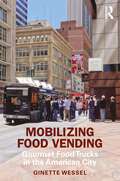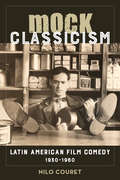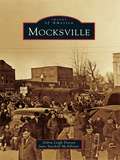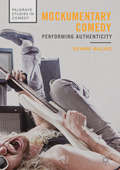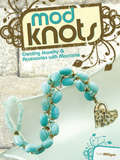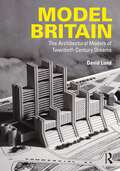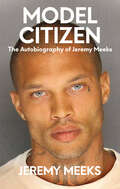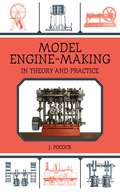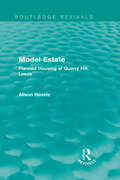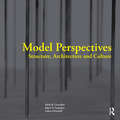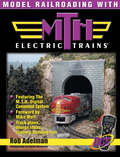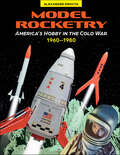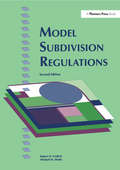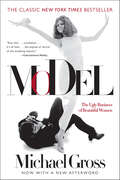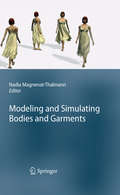- Table View
- List View
Mobile: Photographs from the William E. Wilson Collection (Images of America)
by Marilyn CulpepperBeautiful Mobile, Alabama, on the Gulf of Mexico, has a colorful history dating back to its founding in 1702. Few photographers have captured the essence of Mobile-its people, places, and events-to the extent of master photographer William Ernest Wilson. Wilson's photography vividly depicts Mobile life at the turn of the twentieth century and is the subject of this engaging visual journey. From nationally elected officials such as Theodore Roosevelt to local Mardi Gras royalty, from entrepreneur Gordon Smith of Smith's Bakery to Africa Town founder Cudjoe Lewis, from a stately cathedral to country churches, from thriving banks and theaters to lumber yards and banana docks, the people and places of Mobile are revealed through Wilson's camera as a kaleidoscope of life in a bustling seaport. Artistic shading and Wilson's innate ability to see beyond the lens give his photographs an air of the contemporary while reflecting a bygone era of simplicity. These images simultaneously reveal the height of Victorian photographic art and daily life in one of the South's first major cities. Covering the period from 1894 to 1905, the collection features personalities, street scenes, and architectural treasures of the past. Preserved on their original dry glass negatives, a significant portion of Wilson's Mobile photographs are collected and printed here in a single edition for the first time.
Mobilising Housing Histories: Learning from London's Past for a Sustainable Future
by Peter Guillery David KrollThe problem of creating affordable, adequate housing for a growing population is not a new one. This book, for anyone with a professional or personal interest in improving housing provision everywhere, aims to inspire by offering in-depth studies of London's housing past and seeks to provide sustainable solutions for the future by linking to wider contemporary historical and social contexts. This book will influence today’s housing debates through showcasing lessons from the past and highlights examples that inform the present. The buildings assessed in these case studies will be measured in terms of their longevity, sustained popularity, livability, average densities and productivity. The research and case studies from the book provide an invaluable resource for academics of architecture, urban design, sociology, history and geography as well as professionals, policy makers and journalists.
Mobility and Fantasy in Visual Culture (Routledge Advances in Art and Visual Studies)
by Lewis JohnsonThis volume offers a varied and informed series of approaches to questions of mobility—actual, social, virtual, and imaginary—as related to visual culture. Contributors address these questions in light of important contemporary issues such as migration; globalization; trans-nationality and trans-cultural difference; art, space and place; new media; fantasy and identity; and the movement across and the transgression of the proprieties of boundaries and borders. The book invites the reader to read across the collection, noting differences or making connections between media and forms and between audiences, critical traditions and practitioners, with a view to developing a more informed understanding of visual culture and its modalities of mobility and fantasy as encouraged by dominant, emergent, and radical forms of visual practice.
Mobility and Identity in US Genre Painting: Painting at the Threshold (Routledge Research in Art History)
by Lacey BaradelThis book examines the portrayal of themes of boundary crossing, itinerancy, relocation, and displacement in US genre paintings during the second half of the long nineteenth century (c. 1860–1910). Through four diachronic case studies, the book reveals how the high-stakes politics of mobility and identity during this period informed the production and reception of works of art by Eastman Johnson (1824–1906), Enoch Wood Perry, Jr. (1831–1915), Thomas Hovenden (1840–95), and John Sloan (1871–1951). It also complicates art history’s canonical understandings of genre painting as a category that seeks to reinforce social hierarchies and emphasize more rooted connections to place by, instead, privileging portrayals of social flux and geographic instability. The book will be of interest to scholars working in art history, literature, American studies, and cultural geography.
Mobility and Migration in Film and Moving Image Art: Cinema Beyond Europe (Routledge Advances in Film Studies)
by Nilgun BayraktarMobility and Migration in Film and Moving Image Art explores cinematic and artistic representations of migration and mobility in Europe from the 1990s to today. Drawing on theories of migrant and diasporic cinema, moving-image art, and mobility studies, Bayraktar provides historically situated close readings of films, videos, and cinematic installations that concern migratory networks and infrastructures across Europe, the Middle East, and Africa. Probing the notion of Europe as a coherent entity and a borderless space, this interdisciplinary study investigates the ways in which European ideals of mobility and fluidity are deeply enmeshed with forced migration, illegalization, and xenophobia. With a specific focus on distinct forms of mobility such as labor migration, postcolonial migration, tourism, and refugee mobilities, Bayraktar studies the new counter-hegemonic imaginations invoked by the work of filmmakers such as Ayşe Polat, Fatih Akin, Michael Haneke, and Tony Gatlif as well as video essays and installations of artists such as Kutluğ Ataman, Ursula Biemann, Ergin Çavuşoğlu, Maria Iorio and Raphaël Cuomo. Challenging aesthetic as well as national, cultural, and political boundaries, the works central to this book envision Europe as a diverse, inclusive, and unfixed continent that is reimagined from many elsewheres well beyond its borders.
Mobilités culturelles - Cultural Mobilities (Transferts culturels)
by Pascal Gin et/and Walter MoserLa mobilité – la capacité à se déplacer ou à être déplacé – est un élément si omniprésent dans la vie moderne qu’elle est tenue pour acquise, presque imperceptible en raison de sa constante présence. Dans Mobilités culturelles – Cultural Mobilities, des chercheurs du Canada et du Brésil, écrivant en anglais et en français, s’interrogent sur l’impact et l’influence qu’a la mobilité sur les dynamiques culturelles au sein de leurs deux pays et entre eux. Explorant le mouvement – des gens, des idées et des créations culturelles – et les processus qui affectent ce mouvement, ils apportent de nouvelles perspectives sur la manière dont la mobilité structure les conditions culturelles contemporaines. Intrinsèquement interdisciplinaire, le volume s’appuie sur des contributions provenant entre autres des domaines de la géographie urbaine, des arts visuels, du cinéma, de la littérature, de la danse et du journalisme, soulignant la mobilité comme un domaine important de la recherche universitaire. Aussi intrinsèquement interculturel, il utilise une approche comparative Sud–Nord qui révèle les points communs et les différences entre les contextes canadien et brésilien. Mobilités culturelles – Cultural Mobilities propose une méthode pour l’étude de la mobilité en tant que force culturelle dans la société contemporaine.
Mobilizing Food Vending: Gourmet Food Trucks in the American City
by Ginette WesselMobilizing Food Vending investigates the gourmet food truck movement in the United States and provides a clearer understanding of the social and economic factors that shape vendor autonomy and industry growth. The book features case studies in a variety of American cities and uses top-down and bottom-up urban theory to frame a discussion of food trucks’ rights, displacement, and resiliency. Using ethnographic and archival research collected from industry experts, the book examines vendors’ operational strategies, their regulatory challenges when navigating the city, and their economic, cultural, and political roles in shaping urban space. Mobilizing Food Vending argues that food truck vendors are critical actors that support local economies and contribute to the public realm while shaping regulatory policy from the bottom up. This book will appeal to urban scholars studying the contemporary neoliberal city, the public realm, and communication technology and mobility, as well as to urban planners seeking to understand how vendors shape city plans and policies.
Moby-Dick in Pictures
by Matt KishInspired by one of the world's greatest novels, Ohio artist Matt Kish set out on an epic voyage of his own one day in August 2009. More than one hundred and fifty years following the original publication of Moby-Dick, Kish began illustrating Herman Melville's classic, creating an image a day over the next eighteen months based on text selected from every page of the 552-page Signet Classics paperback edition. Completely self-taught, Kish refused to set any boundaries for the artwork and employed a deliberately low-tech approach in response to the increasing popularity of born-digital art and literature. He used found pages torn from old, discarded books, as well as a variety of mediums, including ballpoint pen, marker, paint, crayon, ink, and watercolor. By layering images on top of existing words and images, Kish has crafted a visual masterpiece that echoes the layers of meaning in Melville's narrative.
Moby-Dick in Pictures: One Drawing for Every Page
by Matt KishA collection of illustrations inspired by lines from every single page of the 552-page Signet Classics paperback edition of Herman Melville's Moby-Dick Inspired by one of the world's greatest novels, Ohio artist Matt Kish set out on an epic voyage of his own one day in August 2009. More than one hundred and fifty years following the original publication of Moby-Dick, Kish began illustrating Herman Melville's classic, creating images based on text selected from every page of the 552-page Signet Classics paperback edition. Completely self-taught, Kish refused to set any boundaries for the artwork and employed a deliberately low-tech approach in response to the increasing popularity of born-digital art and literature. He used found pages torn from old, discarded books, as well as a variety of mediums, including ballpoint pen, marker, paint, crayon, ink, and watercolor. By layering images on top of existing words and images, Kish has crafted a visual masterpiece that echoes the layers of meaning in Melville's narrative. In retrospect, Kish says he feels as foolhardy as Ishmael, the novel's narrator, and as obsessed as Captain Ahab in his quest for the great white whale. "I see now that the project was an attempt to fully understand this magnificent novel, to walk through every sun-drenched word, to lift up all the hatches and open all the barrels, to smell, taste, hear, and see every seabird, every shark, every sailor, every harpooner, and every whale," he says. "It was a hard thing, a very painful thing, but the novel now lives inside me in a away it never could have before." Kish spent nearly every day for eighteen months toiling away in a small closet he converted into an art studio. In order to share the work with family and friends, he started the blog "One Drawing for Every page of Moby-Dick," where he posted art and brief description about his process on a daily basis.
Moby-Dick in Pictures: One Drawing for Every Page
by Matt KishA collection of illustrations inspired by lines from every single page of the 552-page Signet Classics paperback edition of Herman Melville's Moby-Dick Inspired by one of the world's greatest novels, Ohio artist Matt Kish set out on an epic voyage of his own one day in August 2009. More than one hundred and fifty years following the original publication of Moby-Dick, Kish began illustrating Herman Melville's classic, creating images based on text selected from every page of the 552-page Signet Classics paperback edition. Completely self-taught, Kish refused to set any boundaries for the artwork and employed a deliberately low-tech approach in response to the increasing popularity of born-digital art and literature. He used found pages torn from old, discarded books, as well as a variety of mediums, including ballpoint pen, marker, paint, crayon, ink, and watercolor. By layering images on top of existing words and images, Kish has crafted a visual masterpiece that echoes the layers of meaning in Melville's narrative. In retrospect, Kish says he feels as foolhardy as Ishmael, the novel's narrator, and as obsessed as Captain Ahab in his quest for the great white whale. "I see now that the project was an attempt to fully understand this magnificent novel, to walk through every sun-drenched word, to lift up all the hatches and open all the barrels, to smell, taste, hear, and see every seabird, every shark, every sailor, every harpooner, and every whale," he says. "It was a hard thing, a very painful thing, but the novel now lives inside me in a away it never could have before." Kish spent nearly every day for eighteen months toiling away in a small closet he converted into an art studio. In order to share the work with family and friends, he started the blog "One Drawing for Every page of Moby-Dick," where he posted art and brief description about his process on a daily basis.
Mock Classicism: Latin American Film Comedy, 1930-1960
by Nilo CouretIn Mock Classicism Nilo Couret presents an alternate history of Latin American cinema that traces the popularity and cultural significance of film comedies as responses to modernization and the forerunners to a more explicitly political New Latin American Cinema of the 1960s. By examining the linguistic play of comedians such as Cantinflas, Oscarito and Grande Otelo, Niní Marshall, and Luis Sandrini, the author demonstrates aspects of Latin American comedy that operate via embodiment on one hand and spatiotemporal emplacement on the other. Taken together, these parallel examples of comedic practice demonstrate how Latin American film comedies produce a "critically proximate" spectator who is capable of perceiving and organizing space and time differently. Combining close readings of films, archival research, film theory, and Latin American history, Mock Classicism rethinks classicism as a discourse that mediates and renders the world and argues that Latin American cinema became classical in distinct ways from Hollywood.
Mock Modernism
by Leonard DiepeveenHow was the modernist movement understood by the general public when it was first emerging? This question can be addressed by looking at how modernist literature and art were interpreted by journalists in daily newspapers, mainstream magazines like Punch and Vanity Fair, and literary magazines. In the earliest decades of the movement - before modernist artists were considered important, and before modernism's meaning was clearly understood - many of these interpretations took the form of parodies.Mock Modernism is an anthology of these amusing pieces, the overwhelming majority of which have not been in print since the first decades of the twentieth century. They include Max Beerbohm's send-up of Henry James; J.C. Squire's account of how a poet, writing deliberately incomprehensible poetry as a hoax, became the poet laureate of the British Bolshevist Revolution; and the Chicago Record-Herald's account of some art students' "trial" of Henri Matisse for "crimes against anatomy." An introduction and headnotes by Leonard Diepeveen highlight the usefulness of these pieces for comprehending media and public perceptions of a form of art that would later develop an almost unassailable power.
Mocksville
by Debra Leigh Dotson Jane Satchell McallisterOld photographs offer subjective and evocative evidence of the way we lived and worked in years past. Images of America: Mocksville shares the photographic story of the development of the town of Mocksville and its people to the mid-1900s. Named the seat of newly created Davie County in 1839, the town of Mocksville, originally known as Mocks Old Field, existed as early as the Revolutionary War. Photographs support documentary evidence of various trades as well as agricultural pursuits. Not all buildings or homes survive a town's growth, and Mocksville provides evidence of the passing parade of homes that did not survive. History comes alive as we rediscover and share old photographs and contemplate what they divulge of past times and lives.
Mockumentary Comedy: Performing Authenticity (Palgrave Studies in Comedy)
by Richard WallaceThis book is the first to take comedy seriously as an important aspect of the popular mockumentary form of film and television fiction. It examines the ways in which mockumentary films and television programmes make visible—through comedy—the performances that underpin straight documentaries and many of our public figures. Mockumentary Comedy focuses on the rock star and the politician, two figures that regularly feature as mockumentary subjects. These public figures are explored through detailed textual analyses of a range of film and television comedies, including A Hard Day’s Night, This is Spinal Tap, The Thick of It, Veep and the works of Christopher Guest and Alison Jackson. This book broadens the scope of existing mockumentary scholarship by taking comedy seriously in a sustained way for the first time. It ultimately argues that the comedic performances—by performers and of documentary conventions—are central to the form’s critical significance and popular appeal.
Mod Knots: Creating Jewelry and Accessories with Macrame
by Cathi MilliganYes, it's macramé!Creating fabulous jewelry, accessories and even clothing is fantastically easy with macramé. Yes, macramé. The art of knotting is oh-so simple. And oh-so fun, too. Whether you're a first time knotter or a pro at the craft, you'll love the fresh spin that Mod Knots puts on the traditional craft of macramé.Inside you'll learn step by step the basic techniques of macramé as well as how to create 25 projects from yarn, leather, cord and even wire. Your wardrobe will never be the same once you start creating necklaces, bracelets and earrings for every occasion, belts to match any outfit, incredibly soft and cozy scarves, and even one-of-a-kind purses and bags.Let Mod Knots show you all there is to love about macramé!
Model Britain: The Architectural Models of Twentieth Century Dreams
by David LundThroughout the twentieth century architectural models served as the miniature playgrounds in which the future of Britain’s built environment was imagined, and in drawing from the evidence provided by those models today, this book considers how architects, planners, and civil engineers thought about that future by presenting a history of yesterday’s dreams of tomorrow, told through architectural models.Focused not on the making of architectural models but rather the optimistic and utopian visions they were made to communicate, this book examines the possible futures put forward by 120 models made by Thorp, the oldest and most prolific firm of architectural modelmakers in Britain, in order to reveal a century of evolving ideas about how we might live, work, relax, and move. From depictions of unbuilt city masterplans to those of seemingly ordinary shopping centres and motorways, the models featured trace a progression of the architectural, social, political, technological, and economic influences that shaped the design of Britain’s buildings, transport infrastructure, and its towns and cities during a century of relentless change.Illustrated with over 130 photographs, this book will appeal to academics and historians, as well as anyone with an interest in architectural models and the history of Britain’s twentieth century built environment.
Model Citizen: The Autobiography of Jeremy Meeks
by Jeremy MeeksJeremy Meeks first catapulted to fame when his mugshot went viral, earning him the nickname &“Prison Bae.&” But beyond the headlines and the high fashion, Model Citizen reveals a complex journey from hardship to reinvention.This memoir traces Meeks&’s early life of adversity—from an unsettled childhood to the struggles that led to prison and, eventually, to an unexpected turn on the runway. With grit and a drive to rebuild, Meeks transitioned from gang-tied adolescence to modeling and Hollywood. But his story isn&’t about a perfect transformation; rather, it&’s a real and ongoing journey, shaped by resilience and an ever-evolving pursuit of something more.Model Citizen explores the man behind the viral photo, sharing both his triumphs and challenges as he navigates a path from poverty to the glamour of high fashion, in a modern take on the American Dream.Includes 46 photos, featuring 24 full-page color modeling photos by celebrity photographer Jim Jordan.
Model Engine-Making: In Theory and Practice
by J. PocockFirst published in 1888 for beginners, Model Engine-Making is a fascinating and comprehensive guide to building your first steam engine. While steam is no longer "the most important power of the day," this book remains a fascinating in-depth resource for those with either a theoretical or practical interest in building and using small steam engines. Included within this book are over 100 detailed diagrams drawn by the author to illustrate the process of building each engine, including:A simple single-action oscillating cylinder engineMore complex horizontal and vertical slide-valve enginesLaunch, marine, and locomotive enginesAnd finally, even a model boiler!Whether you are a model engine aficionado or love learning about the history of steam engines, this long-standing classic should be in your library.
Model Estate: Planned Housing at Quarry Hill, Leeds (Routledge Revivals)
by Alison RavetzQuarry Hill Flats, once both the pride and shame of its city of Leeds, was an iconic Modernist symbol of the 1930s. It marked the first use of a prefabricated building system for a large-scale council estate, replacing a notorious slum. But it lasted barely a generation – its complete demolition was announced as Alison Ravetz was finishing this study. First published in 1974, this book is unique in its use of all estate records from conception to destruction, as well as in its comprehensive approach, including aspects usually missing in council housing studies – notably the intimate experience of residents, and a fraught, long-drawn-out building period. Ravetz argues that the Flats’ ‘failure’ was due not to social breakdown, as repeatedly alleged, but rather to a rigidity of design and management unable to accommodate gradual, incremental change. This has continuing implications for the operation of bureaucratically designed and controlled ‘social housing’ today.
Model Perspectives: Structure, Architecture and Culture
by Bjorn N. Sandaker Mark R. Cruvellier Luben DimcheffThis book contains a unique collection of various perspectives on the relationship between structures and the forms and spaces of architecture. As such it provides students and professionals alike with an essential sourcebook that can be mined for visual inspiration as well as for textually rich and authoritative insight into the links between structure, architecture, and cultural context. The chapters address fundamental structural elements and systems: columns, walls, beams, trusses, frames, tensile structures, arches, domes and shells. Each chapter is subdivided into two parts: • The essays – introduce the chapters with the reprinting of a curated set of essays and excerpts by various authors that uniquely address how particular structural elements or systems relate in essential fashion to architectural design concepts. • The model studies – physical models of the overall structural systems of several notable contemporary buildings from Europe, North and South America, Africa and Asia are illustrated with large photographs, detail close-ups, and views of their external forms and internal spaces that establish the exceptional qualities of these projects in connecting structural form to architectural design objectives. Mosaic layouts complete the chapters with a collection of photographs of yet more models whose particular details and unique features serve to extend the visual repertoire of the structural type being considered. The combination, juxtaposition and mutual positive reinforcement of these two collections, one largely textual and the other image based, provides the reader with unique and multifaceted insights into how structural forms and systems can be related to architectural design intentions. Conveyed by a strong and deliberate graphical design format, this assembly of materials gets to the very essence of structures within the context of architecture, and will inspire students and practitioners alike to make strategic design decisions for their own projects.
Model Railroading with M.T.H. Electric Trains
by AdelmanThe model railroad empire of MTH Electric Trains continues to steam ahead and revolutionize the O gauge electric train market with its innovative product lines, helping to make O gauge the fastest growing segment in model railroading. This is the first operator's handbook devoted to MTH's unique features and characteristics, including the new MTH Digital Control System. Model railroaders can easily construct a complete MTH railroad with the detailed step-by-step instructions in this full-color reference. Thorough coverage of MTH operating systems and related components helps enthusiasts choose the right layout. First operator's handbook devoted to MTH Electric Trains' unique features and characteristics Features step-by-step construction of a complete railroad layout from the ground up Overviews MTH Electric Trains' components and control systems
Model Rocketry: America’s Hobby in the Cold War 1960–1980
by Alexander ProcykA beautifully illustrated survey of model rockets from the golden age of space flight and the model rocketry hobby, 1960 to 1980. “Space, the final frontier!” These words, first broadcast in 1966, caught the mood of the nation. The period between 1960 and 1980 was the golden age of space flight, and the height of space mania in popular culture. The space age produced countless space-related toys and collectibles; especially interactive were flying model rockets. This is a beautifully illustrated survey of vintage model rockets, with particular emphasis on those produced by Estes. The 80-plus examples featured are survivors, all of which were built and flown in period. Full-color photos of the preserved rockets are accompanied by anecdotes on construction and flight performance, along with examples of packaging and catalog imagery. The models featured in the book include many famous subjects from real life and science fiction such as the space shuttle, Starship Enterprise, SR-71 Blackbird, X-Wing fighter, V-2, Saturn V, and many more. This is a nostalgic gift for children of the space age, and also an inspiration for the budding model rocketeers of the 21st century.
Model Subdivision Regulations
by Robert H. Freilich Michael M. ShultzA major revision of a classic planning text. This book contains a complete model subdivision ordinance for city and county governments as well as more than 100 pages of legal commentary. The model regulations are generally compatible with all state statutes and work in urban, suburban, and rural settings. They show how communities can finance capital facilities, balance new development with existing surroundings, avoid exposure to the legal pitfalls of takings and substantive due process claims, and much more. Two new chapters cover public facilities impact fees and land readjustment. The chapter on impact fees includes a section on regulatory takings law that looks at how prominent U.S. Supreme Court cases have affected property rights, development, and regulation. Each section of the model regulations is followed by insightful commentary that supports, annotates, and documents the text. The authors explore the rationale for using various regulations, basing their arguments on existing statutory authority, case law, and federal constitutional requirements. The commentary identifies and explains changes from the original model regulations. Whether you're drafting new regulations or considering amendments to existing ones, you'll find Model Subdivision Regulations to be an invaluable reference.
Model: The Ugly Business of Beautiful Women
by Michael GrossInvestigative journalist Michael Gross delves into the history of models and takes us into the private studios and hidden villas where models play and are preyed upon, going beyond modeling’s carefully constructed facade of glamour to expose the scandal and untold truths that permeate the seemingly glamorous business.Here for the first time is the complete story of the international model business—and its evil twin: legalized flesh peddling. It’s a tale of vast sums of money, rape both symbolic and of the flesh, sex and drugs, obsession and tragic death. At its heart is the most unholy combination in commerce: beautiful, young women and rich, lascivious men.Fashion insider Michael Gross has interviewed modeling’s pioneers, survivors, and hangers–on, and he tells the story of the greats: Lisa Fonssagrives; Anita Colby, Candy Jones; Dorian Leigh and her sister Suzy Parker; Jean Shrimpton and Twiggy; Veruschka and Lauren Hutton; and today’s supermodel trinity, Christy, Naomi and Linda.
Modeling and Simulating Bodies and Garments
by Nadia Magnenat-ThalmannThe book presents all aspects of body and garment modeling for animated virtual humans. It describes how we can define fast and precise human body shapes, either from input dimensions or from body scans, how we can use predefined motions and retarget them, how we can easily create 3D garments from 2D patterns and animate them, and how we can retarget interactively various garment sizes while giving new body dimensions. A case study presents the making of the award winning film ' High Fashion in Equations'. Finally, the book describes how simulation processes can be applied to the garment industry and how we interact with an online platform for virtual clothing. This book is truly interdisciplinary as it describes the technical concepts as well as the design aspects and the problems of the clothing industry to be solved today.
